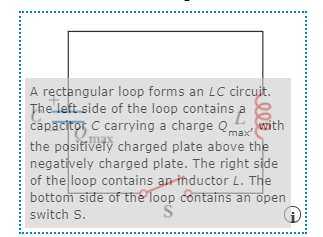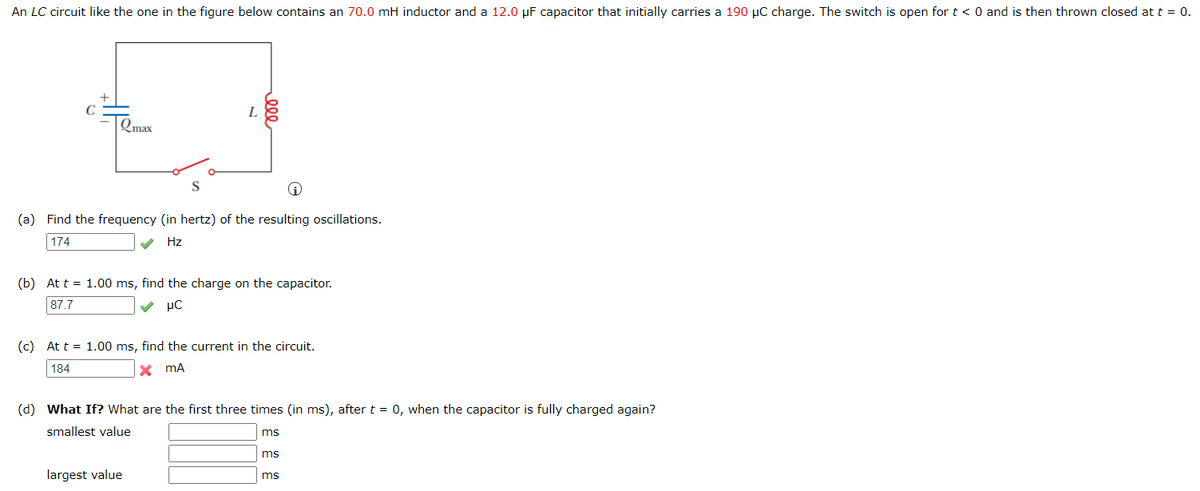An LC circuit like the one in the figure below contains an 70.0 mH inductor and a 12.0 uF capacitor that initially carries a 190 µC charge. The switch is open for t < 0 and is then thrown closed at t = 0. Qmax (a) Find the frequency (in hertz) of the resulting oscillations. 174 v Hz (b) At t = 1.00 ms, find the charge on the capacitor. 87.7 (c) At t = 1.00 ms, find the current in the circuit. 184 |× mA (d) What If? What are the first three times (in ms), after t = 0, when the capacitor is fully charged again? smallest value ms ms largest value ms
An LC circuit like the one in the figure below contains an 70.0 mH inductor and a 12.0 uF capacitor that initially carries a 190 µC charge. The switch is open for t < 0 and is then thrown closed at t = 0. Qmax (a) Find the frequency (in hertz) of the resulting oscillations. 174 v Hz (b) At t = 1.00 ms, find the charge on the capacitor. 87.7 (c) At t = 1.00 ms, find the current in the circuit. 184 |× mA (d) What If? What are the first three times (in ms), after t = 0, when the capacitor is fully charged again? smallest value ms ms largest value ms
Chapter14: Inductance
Section: Chapter Questions
Problem 65P: In an oscillating LC circuit the maximum charge on the capacitor is 2.0 × 10-6 C and the maximum...
Related questions
Topic Video
Question
P11
Please solve Parts (c) & (d)

Transcribed Image Text:A rectangular loop forms an LC circuit.
The left side of the loop contains a
čapacitor C carrying a charge Q writh
the pasitively charged plate above the
negatively charged plate. The right side
of the loop contains an inductor L. The
bottom side of the loop contains an open
switch S.

Transcribed Image Text:An LC circuit like the one in the figure below contains an 70.0 mH inductor and a 12.0 µF capacitor that initially carries a 190 µC charge. The switch is open for t < 0 and is then thrown closed at t = 0.
L
Qmax
S
(a) Find the frequency (in hertz) of the resulting oscillations.
174
Hz
(b) At t = 1.00 ms, find the charge on the capacitor.
87.7
μC
(c) At t = 1.00 ms, find the current in the circuit.
184
x mA
(d) What If? What are the first three times (in ms), after t = 0, when the capacitor is fully charged again?
smallest value
ms
ms
largest value
ms
ele
Expert Solution
This question has been solved!
Explore an expertly crafted, step-by-step solution for a thorough understanding of key concepts.
This is a popular solution!
Trending now
This is a popular solution!
Step by step
Solved in 3 steps

Knowledge Booster
Learn more about
Need a deep-dive on the concept behind this application? Look no further. Learn more about this topic, physics and related others by exploring similar questions and additional content below.Recommended textbooks for you


Physics for Scientists and Engineers, Technology …
Physics
ISBN:
9781305116399
Author:
Raymond A. Serway, John W. Jewett
Publisher:
Cengage Learning

Physics for Scientists and Engineers: Foundations…
Physics
ISBN:
9781133939146
Author:
Katz, Debora M.
Publisher:
Cengage Learning


Physics for Scientists and Engineers, Technology …
Physics
ISBN:
9781305116399
Author:
Raymond A. Serway, John W. Jewett
Publisher:
Cengage Learning

Physics for Scientists and Engineers: Foundations…
Physics
ISBN:
9781133939146
Author:
Katz, Debora M.
Publisher:
Cengage Learning

Physics for Scientists and Engineers with Modern …
Physics
ISBN:
9781337553292
Author:
Raymond A. Serway, John W. Jewett
Publisher:
Cengage Learning

Physics for Scientists and Engineers
Physics
ISBN:
9781337553278
Author:
Raymond A. Serway, John W. Jewett
Publisher:
Cengage Learning

Principles of Physics: A Calculus-Based Text
Physics
ISBN:
9781133104261
Author:
Raymond A. Serway, John W. Jewett
Publisher:
Cengage Learning